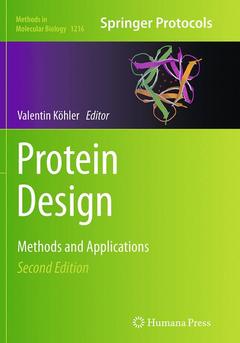Description
Protein Design (2nd Ed., Softcover reprint of the original 2nd ed. 2014)
Methods and Applications
Methods in Molecular Biology Series, Vol. 1216
Coordinator: Köhler Valentin
Language: English
Subject for Protein Design:
Keywords
binary-patterned protein libraries; fluorinated proteins; functional sites of proteins; ketol-acid reductoisomerase; metals; monomeric β-hairpin; non-fluorinated analogous structures; protein variants; structure-forming elements; symmetric protein folds; synthetic; unnatural amino acids; β-sheet peptides; Protein Structure
Support: Print on demand
279 p. · 17.8x25.4 cm · Hardback
Description
/li>Contents
/li>Comment
/li>
Protein Design: Method and Applications, Second Edition expands upon the previous edition with current, detailed ideas on how to approach a potential protein design project. With new chapters on metals as structure-forming elements and functional sites, the design and characterization of fluorinated proteins, top-down symmetric deconstruction and the design of protein libraries and novel or repurposed enzymes. Written in the highly successful Methods in Molecular Biologyseries format, chapters include introductions to their respective topics, lists of the necessary materials and reagents, step-by-step, readily reproducible laboratory protocols, and tips on troubleshooting and avoiding known pitfalls.
Thorough and intuitive, Protein Design: Method and Applications, Second Edition provides a number of practical protocols and instructive reviews to aid in the creation of new experiments.
De novo Design of Stable α-helices.- Design of Monomeric Water-soluble b-hairpin and β-sheet Peptides.- Combination of Theoretical and Experimental Approaches for the Design and Study of Fibril-forming Peptides.- Posttranslational Incorporation of Non-canonical Amino Acids in the RNase S System by Semisynthetic Protein Assembly.- Design, Synthesis, and Study of Fluorinated Proteins.- High-Quality Combinatorial Protein Libraries Using the Binary Patterning Approach.- Methods for Library-Scale Computational Protein Design.- Symmetric Protein Architecture in Protein Design: Top-Down Symmetric Deconstruction.- Identification of Protein Scaffolds for Enzyme Design using Scaffold Selection.- Computational Design of Novel Enzymes without Cofactors.- De novo Design of Peptide Scaffolds as Novel Pre-organised Ligands for Metal-ion Coordination.- Computational Design of Metalloproteins.- Incorporation of Modified and Artificial Cofactors into Naturally Occurring Protein Scaffolds.- Computational Redesign of Metalloenzymes for Catalyzing New Reactions.




